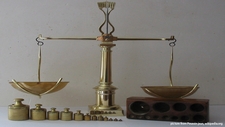Using a Balance

TEKS Objective
The student is expected to collect, record, and analyze information using tools, including calculators, microscopes, cameras, computers, hand lenses, metric rulers, Celsius thermometers, prisms, mirrors, pan balances, triple beam balances, spring scales, graduated cylinders, beakers, hot plates, meter sticks, magnets, collecting nets, and notebooks; timing devices, including clocks and stopwatches; and materials to support observation of habitats of organisms such as terrariums and aquariums.
Essential Understanding
The student knows how to use a variety of tools, materials and methods to conduct science inquiry.
Science Background
Understanding the Basics of Balancing and Measuring Techniques: Balance Technology Inc (PDF) – Detailed explanation of the fundamental principles of balancing.
Balance Theory: Ohaus (website) - This section of the Ohaus Triple Beam Balance site explains how mechanical balances work and discusses the physics involved when using triple beam balances.
Signature Lesson
Measuring Weight: Learn NC (website) - Students build their understanding of the difference between density and weight by using a triple beam balance to measure the mass of different objects, recording their outcomes and discussing the results. Includes assessment.
- Supporting Lessons
- Extensions
- Assessment Ideas
- Literature Connections
- Related
TEKS - Additional Resources
Supporting Lessons
Triple Beam Balance Activities: My Science Lessons Blog (website) - Introduction to the use of a triple beam balance.
Triple Beam Balance Activities
My Science Lessons Blog, mysciencelessons.wordpress.com
Measuring Mass with a Triple Beam Balance: Better Lessons (website) - Investigate mass and matter including a tutorial.
Measuring Mass with a Triple Beam Balance
Better Lessons, www.betterlesson.com
Elaboration Lessons and Extensions
Exploration of a Balance: NCTM Illuminations (website) - In this series of three lessons, students us a balance to explore mass, and investigate patterns and relationships among balance, mass, length of the balance’s mass arm, and the position of the fulcrum.
Exploration of a Balance
NCTM Illuminations, illuminations.nctm.org
Everything Balances Out in the End: NCTM Illuminations (website) - Students balance shapes on an interactive pan balance to study equality. Includes follow-up questions, assessment and extensions.
Everything Balances Out in the End
NCTM Illuminations, illuminations.nctm.org
Assessment Ideas
Have students explain, in writing, the sequence to measure an object’s mass using a triple beam balance.
Practice Weighing: Ohaus Corporation (website) - This interactive activity on the Ohaus website linked below will enable students to test and sharpen their ability to read a triple beam balance.
Literature Connections
Balancing Act. Stoll-Walsh, Ellen (ISBN-13: 978-1442407572)
Mobiles: Building and Experimenting with Balancing Toys. Zubrowski, Bernie (ISBN-13: 978-0688105891)
101 Circus Games for Children. Rooyackers, Paul (ISBN-13: 978-0897935166)
Additional Resources
Triple Beam Balance Tutorial: Ohaus Corporation (website) - Series of interactive, online tutorials that explain set-up and care of a triple beam balance, how to use read the balance, and the scientific principles that make a balance work.
Triple Beam Balance Tutorial
Ohaus Corporation, www.ohaus.com
Metric Mania Lesson Plans: The Science Spot (website) - Links to resources and lessons on measurement, including mass activities using a balance.
Metric Mania Lesson Plans
The Science Spot, www.sciencespot.net
TEKS Navigation
Grade 5
Need Assistance?
If you need help or have a question please use the links below to help resolve your problem.

Comments